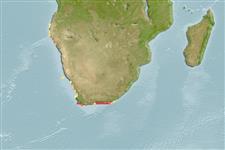分类 / Names
俗名 | 同种异名 | Catalog of Fishes(属, 种) | ITIS | CoL | WoRMS | Cloffa
Teleostei >
Blenniiformes (Blennies) >
Clinidae (Clinids)
Etymology: Xenopoclinus: Greek, xenos = strange + Greek, pous = feet + Greek, klinein, kline = sloping and bed, due to the four apophyses of sphenoid bone (Ref. 45335).
Eponymy: H J Koch from Somerset West, South Africa, was a malacologist who collected the holotype with his wife Anne during their field work in conchology. (Ref. 128868), visit book page.
More on author: Smith.
Environment: milieu / climate zone / depth range / distribution range
生态学
海洋 居于水底的; 深度上下限 0 - 20 m (Ref. 28111). 亞熱帶的
Southeast Atlantic: South Africa.
東南大西洋: 南非。
大小 / 重量 / 年龄
Maturity: Lm ? range ? - ? cm
Max length : 10.0 cm TL 雄鱼/尚未辨别雌雄; (Ref. 5496)
背棘 (总数) : 33 - 37; 背的软条 (总数) : 7 - 11; 臀棘: 2; 臀鳍软条: 29 - 31.
Inhabits intertidal sandy areas near kelp beds. Buries itself in the substrate by diving head first into the sediment and emerging slightly so that the top of the head and the dorsally-situated eyes protrude from the sediment surface. Alternatively, it may lie on the surface of the sediment and use the pectoral, pelvic and anal fins, together with undulatory movements of the body, to insinuate itself into the sediment in a fashion to that of Trachinus vipera. Again, only the top of the head and the eyes are left exposed. Once buried in the sediment, the fish remains there and is able to 'swim' through the sediment for short distances without re-emerging, although it occasionally emerges to undertake short forays (Ref. 28111)
栖息于在海藻床附近的潮间带的沙地。 掩藏于底部以头部先行的方式潜入沉淀物中中而且些微地露出所以头部的顶端与位于背部的眼伸出从沉淀物表面。 或者,它可能躺在沉淀物的表面上而且使用胸鳍, 腹鳍与臀鳍,伴随着身体的波动运动, 蛇龙鰧[Trachinus vipera] 对那迂回地进入在一种方式的沉淀物. 再一次,不过头部与眼的顶端被露出在外。 一旦埋藏在沉淀物中, 鱼逗留在那里而且是能 '游泳' 经过沉淀物短距离再没有出现, 虽然它偶然地浮现进行短的攻击 (参考文献 28111)
Life cycle and mating behavior
成熟度 | 繁殖 | 产卵场 | 卵 | 孕卵数 | 仔鱼
東南大西洋: 南非。
Smith, M.M., 1986. Clinidae. p. 758-769. In M.M. Smith and P.C. Heemstra (eds.) Smiths' sea fishes. Springer-Verlag, Berlin. (Ref. 5496)
世界自然保护联盟红皮书 (Ref. 130435: Version 2024-1)
人类利用
工具
特别资料
下载 XML
网络资源
Estimates based on models
Preferred temperature (Ref.
123201): 16.3 - 20.9, mean 18.1 °C (based on 47 cells).
Phylogenetic diversity index (Ref.
82804): PD
50 = 0.7500 [Uniqueness, from 0.5 = low to 2.0 = high].
Bayesian length-weight: a=0.00513 (0.00223 - 0.01182), b=3.06 (2.86 - 3.26), in cm total length, based on LWR estimates for this (Sub)family-body shape (Ref.
93245).
营养阶层 (Ref.
69278): 3.3 ±0.3 se; based on diet studies.
回复力 (Ref.
120179): 高度, 族群倍增时间少于 15个月 (Preliminary K or Fecundity.).
Fishing Vulnerability (Ref.
59153): Low vulnerability (10 of 100).
